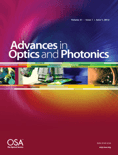
Advances in Optics and Photonics
Scope & Guideline
Transforming Light into Knowledge
Introduction
Aims and Scopes
- Innovative Photonic Technologies:
The journal focuses on the development and application of cutting-edge photonic technologies, including photonic integrated circuits, metamaterials, and nanophotonics. - Quantum Photonics and Information:
A significant emphasis is placed on quantum optics, quantum information technologies, and the manipulation of quantum states, reflecting the journal's commitment to exploring the frontiers of quantum science. - Nonlinear Optics and Dynamics:
Research on nonlinear optical phenomena, including second-order nonlinearities, rogue waves, and high-energy laser interactions, is a core area of focus for the journal. - Optical Materials and Devices:
The journal covers advancements in optical materials such as hexagonal boron nitride and aluminum nitride, as well as their integration into practical devices for various applications. - Applications in Biomedical and Spectroscopic Research:
With a consistent focus on applications, the journal highlights the role of optics in biomedical imaging, spectroscopy, and other fields, showcasing the relevance of photonics in real-world scenarios.
Trending and Emerging
- Artificial Intelligence in Photonics:
There is a growing trend towards the application of artificial intelligence and machine learning in photonics, with research focusing on algorithms for photonic applications and inverse design techniques. - Quantum Technologies and Applications:
Quantum photonics is gaining traction, with increasing publications on quantum information technology and related topics, demonstrating the field's shift towards harnessing quantum phenomena for practical applications. - Integrated and Miniaturized Photonic Devices:
Research on integrated photonic circuits and miniature devices is on the rise, reflecting the demand for compact and efficient photonic systems that can be integrated into various technologies. - Nonlinear and Topological Photonics:
Emerging research in nonlinear optics and topological photonics indicates a trend towards exploring new phenomena and applications, including the manipulation of light in novel ways. - Advanced Spectroscopic Techniques:
The journal is increasingly publishing papers on advanced spectroscopic methods, particularly in biomedical research, showcasing the importance of optics in health and diagnostics.
Declining or Waning
- Traditional Imaging Techniques:
There is a noticeable decline in publications focused on conventional imaging techniques, as the field shifts towards more advanced and integrated approaches such as optical coherence tomography and spatial light interference microscopy. - Classical Optical Theories:
Research centered on classical optics principles is less frequently published, as the journal increasingly prioritizes nonlinear optics and quantum phenomena, reflecting a broader trend towards exploring the complexities of modern photonics. - Basic Optical Materials Studies:
Papers focusing solely on traditional optical materials without innovative applications or integration into devices have decreased, as the emphasis has shifted towards materials with specific photonic applications.
Similar Journals

Optics is a pioneering open access journal published by MDPI, dedicated to advancing the field of optics and photonics. Since its inception in 2020, the journal has fostered the dissemination of high-quality research and innovative developments in optical sciences, contributing significantly to its community of researchers, professionals, and students in Switzerland and beyond. With an impact factor reflective of its growing prominence, Optics strives to address a diverse scope, encompassing atomic and molecular physics, electronic materials, and broader topics in physics and astronomy. The journal's commitment to open access ensures that cutting-edge research is freely available, promoting collaboration and knowledge-sharing across disciplines. As of 2023, it holds a Q4 ranking in several categories, including Atomic and Molecular Physics, and Optics, which illustrates its evolving role in the academic landscape, positioning it as a valuable resource for those seeking to explore the frontiers of optical technology and its applications.
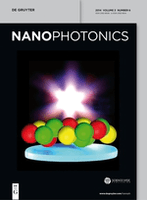
Nanophotonics
Connecting Researchers in the Realm of LightNanophotonics, published by WALTER DE GRUYTER GMBH, is a premier open access journal dedicated to advancing the field of nanophotonics, encompassing cutting-edge research in atomic and molecular physics, optics, biotechnology, and electronic engineering. With a significant impact factor and a notable presence in the top quartile rankings (Q1) across multiple categories, including electrical and electronic engineering, this journal serves as a critical resource for researchers and professionals aiming to explore the latest developments in the manipulation of light at the nanoscale. Since its inception in 2012, Nanophotonics has been an influential platform for disseminating innovative ideas and breakthroughs, offering unrestricted access to its content, thus fostering a collaborative environment conducive to scientific discovery. Located in Berlin, Germany, and with a commitment to promoting the highest standard of scholarly excellence, Nanophotonics continues to shape the future of optical materials and technology, inviting contributions from both established experts and emerging scholars.

JOURNAL OF RUSSIAN LASER RESEARCH
Pioneering Research in Optics and EngineeringThe Journal of Russian Laser Research, published by Springer, stands as a vital resource for researchers and professionals in the fields of atomic and molecular physics, as well as optics and engineering. With its ISSN 1071-2836 and E-ISSN 1573-8760, this journal has been disseminating groundbreaking research since its inception in 1994, with a dedicated focus on the advancement of laser technologies and their applications. While it currently holds a Q4 classification in both Atomic and Molecular Physics and Engineering categories, its commitment to fostering novel insights and innovative methodologies positions it as a promising platform for emerging studies within these disciplines. Although the journal does not offer open access options, it continues to draw attention with a growing citation index. By publishing diverse research articles, reviews, and critical discussions, the Journal of Russian Laser Research not only enriches academic literature but also serves as a stepping stone for students and professionals seeking to deepen their understanding of laser science and its myriad applications.

PhotoniX
Catalyzing Progress in the World of LightPhotoniX is a premier open-access journal published by SPRINGERNATURE in Germany, dedicated to the fields of Atomic and Molecular Physics, Optics, and Electrical and Electronic Engineering. Launched in 2020, this journal has swiftly established itself as a key resource within the scientific community, achieving impressive rankings, notably being placed in the Q1 quartile across its categories in 2023. With its Scopus ranks highlighting its excellence—2nd in Engineering (Miscellaneous), 9th in Electrical and Electronic Engineering, and 6th in Atomic and Molecular Physics—PhotoniX serves as a critical platform for researchers to disseminate their findings. With an emphasis on broadening access to cutting-edge research, the journal offers a valuable opportunity for engagement with contemporary advancements in the fields it covers. Researchers, professionals, and students can benefit significantly from its contents, contributing to the collective knowledge in these vital areas of science and technology.

Optica
Breaking barriers in optical research and knowledge sharing.Optica is a premier open-access journal published by the Optica Publishing Group, designed to disseminate high-quality research across the fields of Atomic and Molecular Physics and Optics. Since its inception in 2014, it has established itself as a vital resource for the scientific community, as evidenced by its impressive Q1 rankings in both relevant categories in 2023 and its notable positions in the Scopus rankings—#9 in Atomic and Molecular Physics and #13 in Materials Science. Featuring cutting-edge research from leading experts, Optica aims to foster innovation and collaboration by providing unrestricted access to groundbreaking discoveries and advancements. Researchers, professionals, and students alike will find invaluable insights and trends that drive the ever-evolving scope of optical science and materials technology. With its commitment to open access, Optica ensures that knowledge is accessible, empowering the global community of scientists and researchers to embark on new explorations.

Light-Science & Applications
Pioneering Discoveries in Atomic and Molecular PhysicsLight-Science & Applications is a prestigious open-access journal published by SPRINGERNATURE, dedicated to advancing the fields of Atomic and Molecular Physics, Optics, and Electronic, Optical, and Magnetic Materials. Established in 2012 and located in the United Kingdom, this journal has rapidly gained recognition, evidenced by its impressive 2023 rankings; it is situated in Q1 within its categories, boasting a rank of #5 out of 224 in Physics and Astronomy and #8 out of 284 in Materials Science, placing it in the esteemed 97th percentile. It is committed to disseminating high-quality research that explores innovative applications of light and materials science, making it an invaluable resource for researchers, professionals, and students alike. As an open-access platform, Light-Science & Applications ensures that its research is freely accessible, fostering collaboration and knowledge exchange within the scientific community. With its converged years spanning from 2012 to 2024, the journal remains at the forefront of impactful developments in light science.

Nonlinear Optics Quantum Optics-Concepts in Modern Optics
Advancing Knowledge in Nonlinear and Quantum OpticsNonlinear Optics Quantum Optics-Concepts in Modern Optics is a specialized journal published by OLD CITY PUBLISHING INC, focusing on the forefront of research in nonlinear optics and quantum optics. With an ISSN of 1543-0537 and an E-ISSN of 1944-8325, this journal serves as a pivotal platform for the dissemination of innovative concepts and findings in modern optics, significant for both theoretical exploration and practical applications. Established in 2003, the journal's scope encompasses critical areas such as atomic and molecular physics, optical materials, and instrumentation, attracting submissions from a diverse range of interdisciplinary fields. While the journal currently maintains a Q4 ranking in several categories, it continues to strive for higher visibility and impact in the academic community. Researchers and students alike will find valuable insights and contributions that foster advancements in optical science and engineering. With an emphasis on rigorous peer-review, Nonlinear Optics Quantum Optics-Concepts in Modern Optics is committed to enhancing the understanding and application of nonlinear optical phenomena in various technological domains.
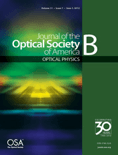
JOURNAL OF THE OPTICAL SOCIETY OF AMERICA B-OPTICAL PHYSICS
Navigating the Landscape of Optical Research ExcellenceJOURNAL OF THE OPTICAL SOCIETY OF AMERICA B-OPTICAL PHYSICS, published by Optica Publishing Group, serves as a leading platform for groundbreaking research in the fields of optical physics, atomic and molecular physics, and statistical and nonlinear physics. With an ISSN of 0740-3224 and an E-ISSN of 1520-8540, this esteemed journal has been in circulation since 1984 and is dedicated to advancing the understanding of optical phenomena and related technologies. It holds a commendable position in the academic community, with a 2023 Scopus ranking reflecting its significance—placing it in the top quartile for both Atomic and Molecular Physics and Statistical and Nonlinear Physics. Although it is not an open-access publication, it provides extensive access options to ensure that research is disseminated effectively within the scientific community. This journal is instrumental for researchers, professionals, and students alike, aiming to keep them informed of the latest advancements and trends in optical science. With a convergence of expertise and innovation, JOSA B continues to play a pivotal role in shaping the future of optical research.
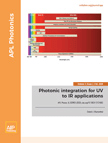
APL Photonics
Shaping the Next Wave of Photonic InnovationAPL Photonics is a premier open-access journal published by AIP Publishing, dedicated to the field of photonics, encompassing a broad range of research areas including atomic and molecular physics, optics, and computer networks and communications. Since its inception in 2016, the journal has positioned itself at the forefront of innovation, earning Q1 quartile rankings in both relevant categories as of 2023. With an impressive Scopus ranking that places it in the 87th and 89th percentiles for its respective fields, APL Photonics serves as a vital platform for rapid dissemination of high-impact research. Its open-access policy ensures that cutting-edge findings are accessible to researchers, professionals, and students globally, facilitating collaboration and knowledge sharing. Aimed at fostering advancements in the photonics community, this journal is essential for those looking to stay informed on the latest breakthroughs and trends in photonic technologies.
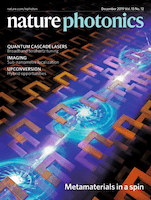
Nature Photonics
Transforming Ideas into Light: The Photonics JournalNature Photonics, published by NATURE PORTFOLIO, stands as a leading journal in the realm of photonics, specializing in the convergence of atomic and molecular physics and optics, as well as electronic, optical, and magnetic materials. Established in 2007 and continuing through 2024, this esteemed journal boasts an impressive 2023 ranking of Q1 in both its primary categories, highlighting its importance and influence within the scientific community. With a Scopus rank of #3 in both materials science and physics categories, and a remarkable 99th percentile ranking, Nature Photonics serves as a vital platform for disseminating pioneering research and innovative discoveries that drive the field forward. Although it does not currently offer open access options, the journal remains accessible to a broad audience interested in the latest advancements in photonics, including researchers, professionals, and students eager to explore cutting-edge developments. By fostering a community of collaboration and knowledge exchange, Nature Photonics continually shapes the future of photonics research.